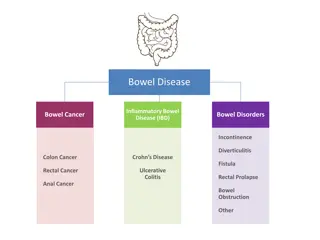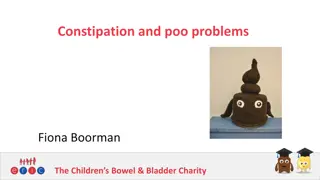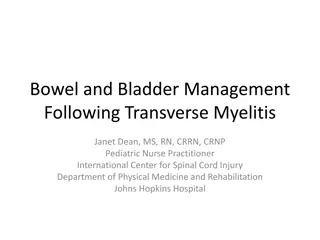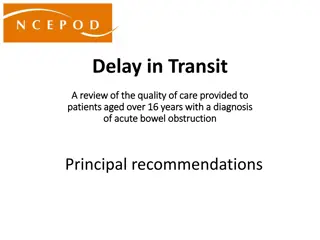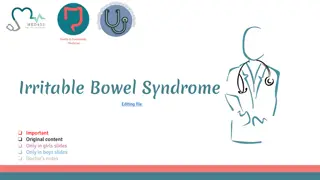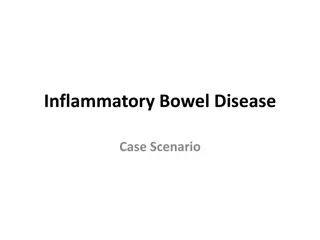Understanding Bowel Diversion Ostomy: Definition, Classification, and Management
Bowel diversion ostomy involves creating an opening in the gastrointestinal tract to divert and drain fecal material. This summary covers the definition, purpose, classification (permanent vs. temporary ostomies, types of intestinal ostomies), management, assessment, and changes associated with ostomies. It also outlines nursing responsibilities and considerations for different types of drainage and stoma constructions.
Download Presentation

Please find below an Image/Link to download the presentation.
The content on the website is provided AS IS for your information and personal use only. It may not be sold, licensed, or shared on other websites without obtaining consent from the author. Download presentation by click this link. If you encounter any issues during the download, it is possible that the publisher has removed the file from their server.
E N D
Presentation Transcript
BOWEL DIVERSION OSTOMY Prepared by: DR. IRENE ROCO Asst. Professor
Outline Definition of Bowel Diversion Ostomy Purpose Classification a. status b. Anatomic location c. surgical construction Ostomy Management Assessment Ostomy change References
Definition OSTOMY an opening for the gastrointestinal, urinary, or respiratory tract into the skin PURPOSE Divert and drain fecal material
CLASSIFICATION OF BOWEL DIVERSION OSTOMIES 1. Status a. Permanent to provide means of elimination when the rectum or anus is non functional ( birth defect / cancer) b. Temporary for traumatic injuries or inflammatory conditions of the bowel, allowing the bowel to rest and heal
CLASSIFICATION OF BOWEL DIVERSION OSTOMIES TYPES OF INTESTINAL OSTOMY: 1. Gastrostomy opening through the abdominal wall in the stomach 2. Jejunostomy - opening through the abdominal wall in the jejunum 3. Ileostomy - opening through the abdominal wall in the ileum 4. Colostomy - opening through the abdominal wall in the colon
CLASSIFICATION OF BOWEL DIVERSION OSTOMIES Type of drainage Liquid fecal drainage; no control Nursing Responsibility Instruct Client to wear appliance continuously and take special precautions to prevent skin breakdown Odor is minimal because fewer bacteria are present Ileostomy / ascending colostomy Transverse colostomy Malodorous, mushy drainage ; liquid has been reabsorbed; no control Solid fecal drainage Descending colostomy sigmoidosto my Normal or formed consistency ; can be controlled Client may not have to wear appliance at all times
CLASSIFICATION OF BOWEL DIVERSION OSTOMIES 3. Construction of the stoma a. single one end of the bowel is brought out through an abdominal opening b. Loop loop of bowel is brought into the abdominal wall and supported by a plastic bridge , or a piece of rubber tubing; has two openings (proximal and distal)
CLASSIFICATION OF BOWEL DIVERSION OSTOMIES 3. Construction of the stoma c. Divided colostomy two edges of bowel brought out into the abdomen but separated from each other d. Double barrel - proximal and distal loops of bowel are sutured together for about 10 cm and both ends are brought up into the abdominal wall Divided colostomy Double barrel
OSTOMY APPLIANCE Consist of : skin barrier Pouch can be closed or dainable Adjustable Ostomy belt
OSTOMY MANAGEMENT Consists of group of nursing interventions that may be necessary after fecal diversion surgery Stoma assessment Application of stoma to collect feces and protect skin Promotion of self care
Assessment Assess for: Color Normal Healthy pink, red and slightly moist Abnormal Dusky dark ( pink / bluish (cyanosis) suggest inadequate circulation to the stoma Failure to recede may indicate blockage Size and shape New stoma are swollen; swelling decreases in 2-3 weeks or as long as 6 weeks Position Must remain on the abdominal surface If stoma retracts, feces may enter the abdominal cavity and cause peritonitis; Prolapse must be reported to the doctor Report other bleeding Stomal bleeding Complaints Slight bleeding Burning sensation under the skin may indicate skin breakdown Abdominal discomfort / distention
OSTOMY CHANGE Can be applied for up to 7 days Twice a week Change whenever the stool leaks onto the peristomal skin Every 24 48 hrs if the skin is erythematous, eroded, or ulcerated More frequent changes if client complains of pain or discomfort The pouch is emptied when it is one third to one half full If the pouch overfills, it can cause separation of the skin barrier and stool comes in contact with the skin
PURPOSE OF OSTOMY CHANGE To assess and care for peristomal skin To collect stool for assessment of the amount and type of output Minimize odors for the client s comfort and self esteem
References Kozier & Erbs Fundamentals of Nursing . Eighth ed. 2008 Potter Perry. Basic Nursing 6th ed..Mosby, Missouri, 2006.



